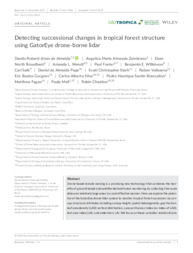Detecting successional changes in tropical forest structure using GatorEye drone-borne lidar.
Detecting successional changes in tropical forest structure using GatorEye drone-borne lidar.
Author(s): ALMEIDA, D. R. A. de; ZAMBRANO, A. M. A.; BROADBENT, E. N.; WENDT, A. L.; FOSTER, P.; WILKINSON, B. E.; SALK, C.; PAPA, D. de A.; STARK, S. C.; VALBUENA, R.; GORGENS, E. B.; SILVA, C. A.; BRANCALION, P. H. S.; FAGAN, M.; MELI, P.; CHAZDON, R.
Summary: Drone-based remote sensing is a promising new technology that combines the benefits of ground-based and satellite-derived forest monitoring by collecting fine-scale data over relatively large areas in a cost-effective manner. Here, we explore the potential of the GatorEye drone-lidar system to monitor tropical forest succession by canopy structural attributes including canopy height, spatial heterogeneity, gap fraction, leaf area density (LAD) vertical distribution, canopy Shannon index (an index of LAD), leaf area index (LAI), and understory LAI. We focus on these variables? relationship to aboveground biomass (AGB) stocks and species diversity. In the Caribbean lowlands of northeastern Costa Rica, we analyze nine tropical forests stands (seven secondgrowth and two old-growth). Stands were relatively homogenous in terms of canopy height and spatial heterogeneity, but not in their gap fraction. Neither species density nor tree community Shannon diversity index was significantly correlated with the canopy Shannon index. Canopy height, LAI, and AGB did not show a clear pattern as a function of forest age. However, gap fraction and spatial heterogeneity increased with forest age, whereas understory LAI decreased with forest age. Canopy height was strongly correlated with AGB. The heterogeneous mosaic created by successional forest patches across human-managed tropical landscapes can now be better characterized. Drone-lidar systems offer the opportunity to improve assessment of forest recovery and develop general mechanistic carbon sequestration models that can be rapidly deployed to specific sites, an essential step for monitoring progress within the UN Decade on Ecosystem Restoration.
Publication year: 2020
Types of publication: Journal article
Unit: Embrapa Acre
Keywords: Aboveground biomass, Aerial surveys, Biomasa aérea, Biomassa aérea, Bosques lluviosos, Bosques secundarios, Caribbean lowlands, Drone, Floresta Secundaria, Floresta Tropical, Forest restoration, GatorEye, Heredia Province, Lidar, Monitoreo, Monitoring, Northeastern Costa Rica, Rain forests, Raio Laser, Reconhecimento Florestal, Regeneração florestal, Remote sensing, Restauración de bosques, Sarapiquí, Secondary forests, Sensoriamento Remoto, Teledetección, Unmanned aerial vehicles, Vehículos aéreos no tripulados
Observation
Some of Embrapa's publications are published as ePub files. To read them, use or download one of the following free software options to your computer or mobile device. Android: Google Play Books; IOS: iBooks; Windows and Linux: Calibre.
Access other publications
Access the Agricultural Research Database (BDPA) to consult Embrapa's full library collection and records.
Visit Embrapa Bookstore to purchase books and other publications sold by Embrapa.

